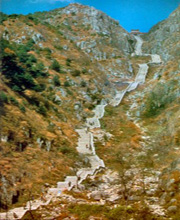The stairs are one of the oldest buildings in architectural history,they have always played a central role in the history of humanity,although it is difficult to tell exactly in wich year they were born,it is believed his appearance was by the year 6000 before Christ. Thestairs seems to change shape with the change of architectural eras,reflecting the trends used in different ages and revealing the talentof those who designed them.
The first stairs in the history were wood trunks fitter together, thesekind of stairs were used to acquire strategic positions for survival.In a basic sense, the first use which was given to the stairs was toovercome the difficulties presented by the terrain, such as valleys ormountains, the goal was to be able to pass these difficulties as soonas possible, move up often meant moving to a place of greater security,then this could have meant at that time the difference between life anddeath, it was very important to move quickly, hence the importance ofthe stairs.


In the history of the stairs they first emerged as a solution to aproblem, although, years later it was found in China the first granitestaircase leading to the sacred mountain in Tai Shan, this indicatesthat one of the utilities that was given to the stairs in his story wasfor religious purposes. Confucius in one of his stories said to havegone up this ladder to the top in the year 55 BC. The ladder was usedin a metaphoric way reach the divine height and establish a connectionbetween earth and sky. Other examples of stairs built for religiouspurposes are: the biblical Jacob's ladder, the tower of Babel, whichwas a helical tower, the pyramids of Egypt that had stairs, thecelestial ladder of Shantung in China, the stairs in India, apeculiarity of the stairs in India is that they had also scientificutility. All these stairs have something in common, they symbolize therise of the light, the sun, and a way in to the gods path.

Later in the history of stairs, spiral stairs wede used in clastles formilitary reasons, the proliferation of spiral stairs in castles was notcasual, they allow a strategic position to the soldier who defended thecastle, these spiral staircases and railings were built in order tomake the solder placed in top an advantage, this soldier would have hisright hand full of space to move his sword, while the woldier placed onthe bottom would constantly hit the wall whily fighting, because hewould have blocked part of the range of motion of his right, besides,his head would be easy to reach for his opponent, the lack of handrailswas not casual, the aim was to push the opponent over the edge of thestair.
Stairs in the Present
The end of the nineteenth century is regarded by many as the golden eraof construction of stairs, Peter Nicholson developed a mathematicalsystem for stairs and railings approaching the art of the stairs to theworkers of wood and metal. By the end of 1980 Eva Jiricna in Londonstarted designing stairs in glass and stainless steel which gave thestairs a sleek and futuristic look.
Today it is increasingly common to exit the conventional design of ironand wood and move on to different materials such as stainless steel,glass and titanium.
memandangkan komen berdasarkan gambo2 nih.. aku nomborkan gambo k? senang nak refer korg komen yg mana...